June 16, 2023
Introducing Apple Vision Pro: Apple’s first spatial computer
On June 5th, Apple just unveiled Apple Vision Pro, a revolutionary spatial computer that seamlessly blends digital content with the physical world, while allowing users to stay present and connected to others. Vision Pro creates an infinite canvas for apps that scales beyond the boundaries of a traditional display and introduces a fully three-dimensional user interface controlled by the most natural and intuitive inputs possible — a user’s eyes, hands, and voice. Featuring visionOS, the world’s first spatial operating system, Vision Pro lets users interact with digital content in a way that feels like it is physically present in their space. The breakthrough design of Vision Pro features an ultra-high-resolution display system that packs 23 million pixels across two displays, and custom Apple silicon in a unique dual-chip design to ensure every experience feels like it’s taking place in front of the user’s eyes in real time.
How It Works
Apple Vision Pro is a “mixed reality” headset, meaning it can display both virtual and augmented reality content. It is not like augmented reality glasses, however, as it is designed to completely cover the eyes and block out all of your surroundings.
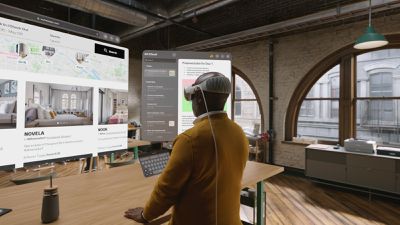
Apple is using exterior and interior cameras for the augmented reality component of the device. The cameras are able to map the space around you and project the real world back to you, so though you’re not actually looking at what’s around you using see-through glasses, you are effectively seeing an accurate picture of your real world environment.
With this capability, Apple can show you 3D windows, objects, and content in your actual space, or the cameras can be turned off to shut out the world to provide an entirely virtual setting. Apple is focusing on the headset’s ability to allow for working, content consumption, gaming, communication and other activities to be done “anywhere” with just the Vision Pro.
Design
Vision Pro is Apple’s wearable “spatial computing” device, and while Apple does not refer to it as a headset, that’s exactly what it is. The Apple Vision Pro is worn over the head, and it is a virtual/augmented reality headset with similar to the PlayStation VR or Meta Quest.
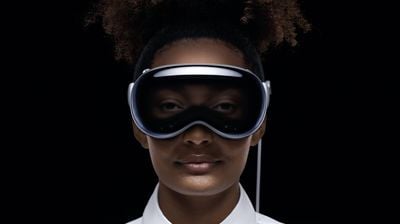
Design wise, the Vision Pro looks similar to a pair of ski goggles, albeit high-end goggles. It features a laminated glass front, which Apple says was “three-dimensionally formed.” The glass is attached to a curved aluminum alloy frame that wraps around the face. As of now, the headset is only available in silver with matching gray Light Seals and bands.
The frame connects magnetically to a Light Seal that sits on the face, and Apple offers the Light Seal in a range of sizes and shapes to fit different faces. A tight fit with the Light Seal is essential for blocking out light and proper operation of the headset. Apple designed the Light Seal to be flexible so that it can conform to individual face shapes.
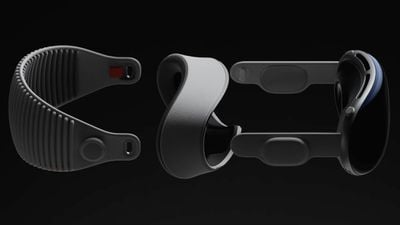
At the side of the headset, there are two audio straps that are equipped with speakers that support spatial audio. The audio straps connect to a 3D braided fabric strap that secures the headset to the back of the head, with an adjustable dial for tightening it up for a customizable fit. The main braided headband is detachable so users will be able to swap in different sizes, and perhaps different designs if Apple makes those available in the future.
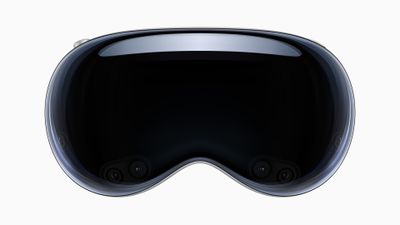
Apple created the rib structure of the headband to provide cushioning, breathability, and stretch so that it would be comfortable to wear for long periods of time.
There is also a secondary strap that can go over the head for better weight distribution. Apple has not provided much info about this secondary strap, nor has the company divulged the weight of the headset at the current time.
Physical controls include a Digital Crown at the top that changes your level of “immersion” and to show you more or less of your real world surroundings through “Environments,” and a top button that serves as a camera button for capturing 3D “spatial” videos and photos.
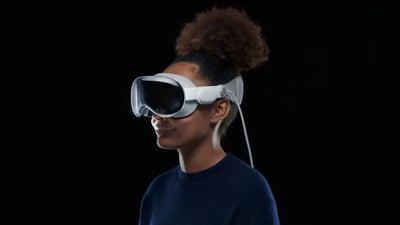
On the left side of the headset, there is a space to attach a braided cable that provides power to the device. The round charging puck looks like an Apple Watch charging puck, but it clicks into the headset securely with a rotation gesture.
The charging cable attaches to either an external battery pack worn at the waist or a power adapter connected to the wall.
Display
Apple Vision Pro is equipped with two custom micro-OLED displays that provide a total of 23 million pixels, which Apple says is “more pixels than a 4K TV.” The headset displays feature a 90Hz refresh rate, but there is a 96Hz refresh rate that can be activated when watching 24 fps movies.
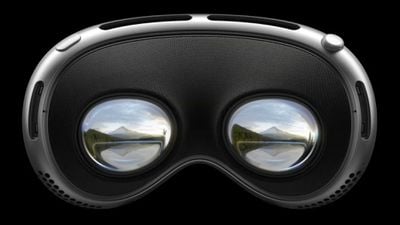
The displays have been describe as the size of a postage stamp, but specific hardware information is not known yet.
There’s also an external “EyeSight” display that shows the headset wearer’s eyes to the people in the room around them. The feature is designed to allow people to know if the headset wearer is using a less immersive augmented reality mode or a fully immersive virtual reality mode.
The eye display that is shown on the exterior display comes from an interior camera that is monitoring the wearer’s eyes. It can also alert people when you are recording video with the external camera.
Lens Inserts
Apple Vision Pro customers who wear glasses will be able to order Zeiss Optical inserts with their prescription. This will be a separate cost, but pricing has not yet been announced. The lenses will attach magnetically to the displays inside the headset.
Cameras and Sensors
Apple Vision Pro includes 12 cameras and five sensors for monitoring hand gestures and mapping the external environment.

Two of the cameras transmit more than a billion pixels per second to the display to depict the real world around the wearer when using augmented reality mode, while the others are used for head tracking, hand tracking, and real-time 3D mapping.
Infrared flood illuminators enhance hand tracking in low-light conditions, and LiDAR depth sensors determine the size and location of objects in the room around you.
![]()
Four infrared cameras and LED lights are inside the headset for eye tracking purposes. With this technology, the Vision Pro is able to tell exactly where the wearer is looking for navigation purposes.
Navigation
There are no physical controls for the Vision Pro. Navigation is done through eye movements, hand gestures, and voice-based commands. In visionOS, for example, you can highlight an element like an app icon by looking at it, using a quick hand gesture to launch the app.
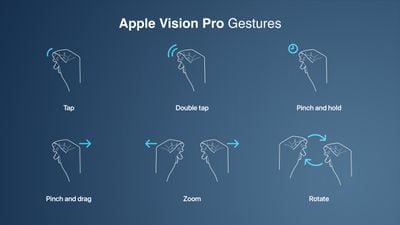
Bluetooth keyboards, mice, trackpads, and game controllers can be connected to Vision Pro as an alternative navigation method, though these are mainly designed to be used with a connection to the Mac and for Apple Arcade games.
Optic ID
The infrared cameras and LED lights inside the Vision Pro are used for a security feature called Optic ID. Optic ID is similar to Touch ID or Face ID, but it uses iris scanning instead of a facial scan or a fingerprint scan.
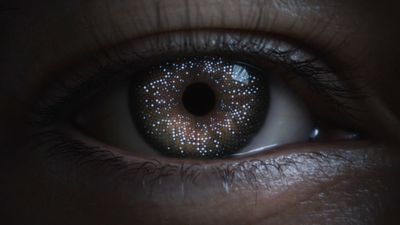
Each person has a unique iris pattern, which the headset is able to detect to keep sensitive data on the headset secure. Optic ID can be used like Face ID for unlocking the device, authenticating purchases, and as a password alternative.
3D Camera
Apple included an exterior camera that is able to capture 3D video and 3D photos that are viewable in 3D on the Vision Pro. Apple says that these are like reliving a memory in person because of the “incredible depth” that’s available.
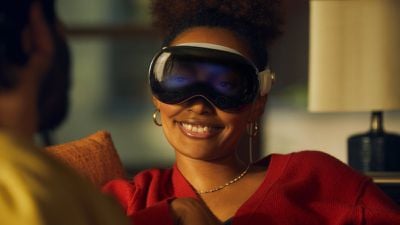
The camera gives a clear indicator when recording is turned on so that the headset cannot be used to secretly record video.
Audio
There are speakers on either side of the headset, with the speakers built into the straps that are connected to the frame. The speakers feature dual-driver audio pods that are positioned next to each ear, and they are able to analyze a room’s acoustic properties to adapt the sound to match the space.
The speakers support spatial audio for an immersive surround sound experience, plus there are also six microphones for phone calls, video calls, and voice commands.
Processors
Apple Vision Pro is powered by a pair of chips. The main processor is the M2, which is the same chip that was first introduced in the 2022 MacBook Air. It is responsible for processing content, running the visionOS operating system, executing computer vision algorithms, and providing graphical content.
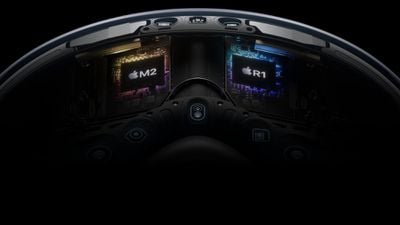
A second R1 chip is responsible for all of the information coming from the cameras, sensors, and microphones. Apple says that it can stream images to the displays within 12 milliseconds, providing a “virtually lag-free” view of the world.
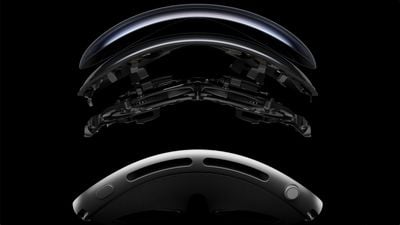
There is a thermal system inside the Vision Pro that is designed to quietly move air through the headset to control heat and optimize performance.
Battery Life
With the external battery pack, the Vision Pro can run for approximately two hours. Battery packs can be swapped out for additional power on the go, but the device ships with a single battery pack.
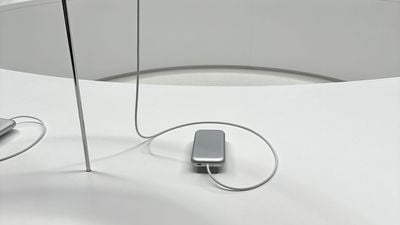
When plugged in to a power adapter, the Vision Pro can run all day.
visionOS
Apple Vision Pro runs visionOS, an operating system that Apple designed specifically for the headset. visionOS is designed to provide an “infinite canvas” with app windows able to go anywhere in the space surrounding the user.

Apple redesigned apps like Safari, FaceTime, Messages, and more to work in a 3D environment, plus the headset is able to run the full catalog of iPhone and iPad apps. iPhone and iPad apps aren’t optimized for 3D, but can be used on the virtual canvas.
Movies and TV shows are available through Apple TV+ and other apps, and can be adjusted to look they’re on a screen that’s “100 feet wide.” visionOS has its own App Store, and specially created immersive 3D content created by Apple.
visionOS is described as the first spatial operating system because it can be controlled with eyes and hand gestures, with no physical controls necessary.
Mac Integration
visionOS can be used with a Mac, serving as a display. It works as a giant external display for Mac content, with familiar controls available through connected keyboards, mice, and trackpads.
How to Buy
The Vision Pro is not available as of yet. Apple plans to release it sometime in early 2024, and it will be available.
What to buy instead?
If you’re looking for a cheaper alternative, you can go with Meta Quest 2, HTC Vive or Samsung Odyssey! They’re lightweight and comfortable design, with built-in sensors for room-scale tracking, and hand-tracking capabilities. All of them offer a high-resolution display with improved graphics, making the virtual worlds more detailed and realistic.
You can find the specs for each VR headset in the following table:
Specs | Oculus Quest 2 | HTC Vive | Samsung Odyssey |
Max Field of View | 100° | 110° | 110° |
Max Resolution | 1832×1920 per eye | 2160×1200 (1080×1200 per eye) | 2880 x 1600 (1440 x 1600 per eye) |
Screen Type | Fast Twitch LCD | Dual AMOLED | AMOLED |
Pixel Density | 538ppi | 461ppi | 615ppi |
Sensors | Accelerometer, | Accelerometer, | Accelerometer, gyroscope, magnetometer |
Max Refresh Rate | 120Hz | 90Hz | 90Hz |
Tracking | 6DOF Inside Out Tracking (wireless) | 6 DOF IR Laser-based | 2 x 6 DOF camera |
|
|
|
|


